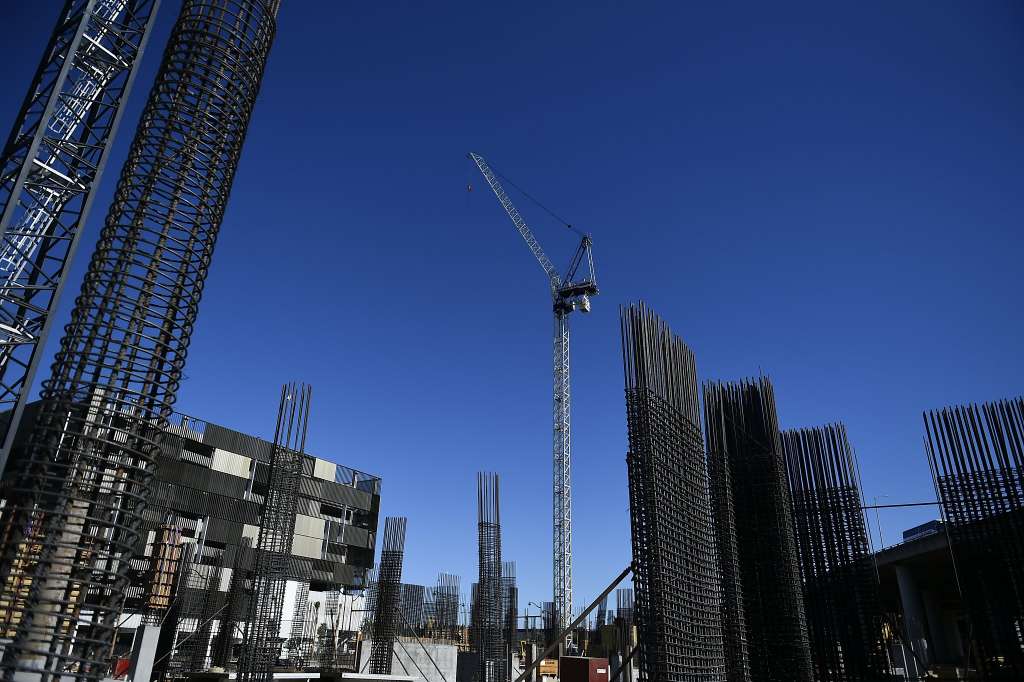Mega billions: a look at some of the biggest US construction projects underway


Many in the construction industry consider a project that costs $1 billion or more a megaproject. However, there are a number of U.S. developments underway that make $1 billion seem like small change. And not all of them are massive energy or public works projects. Private money is also driving behemoths.
Here are five of the biggest projects underway nationwide.
Related Santa Clara

Cost: $8 billion
Location: Santa Clara, California
Related Cos., the developer behind the $25 billion Hudson Yards project in Manhattan, is turning a 240-acre former landfill turned golf course and dirt BMX track into an $8 billion massive mixed-use project. Site work started in May, and vertical construction is slated for the beginning of next year.
The lead architect for the initial phases of Related Santa Clara is Foster + Partners, which will work with executive architect Gensler.
The 9.2 million-square-foot development, located in Silicon Valley, is a public-private partnership between the City of Santa Clara and Related Urban, Related’s mixed-use division. When complete, the project will offer:
- 30 acres of public space.
- 5.4 million square feet of commercial office space.
- Almost 1,300 residential apartments.
- 400 extended-stay apartments.
- 1 million square feet of shopping, dining and entertainment space.
- An Equinox hotel.
- Access to public transportation and major highways.
- Pedestrian and bike paths.
The project also sits next to Levi’s Stadium, home to the NFL’s San Francisco 49ers.
Santa Clara officials had to wage a legal battle against neighboring San Jose, California, in order to move the Related project forward. San Jose sued Santa Clara first, arguing that there wasn’t enough housing in the area — or within Related Santa Clara — to support the development and that it would drive already sky-high home prices even higher and put too many additional cars on local roads. Santa Clara hit back with a lawsuit that threatened a large office project, but both suits have since been settled.
The 78

Cost: $7 billion
Location: Chicago
It’s not easy pushing projects of this magnitude through the Chicago approval process, yet another division of Related, Related Midwest, scored that win with $7 billion for The 78 in April. The project is so big that it’s creating a new neighborhood in the city. There are 77 distinct neighborhoods that make up the Windy City, and Related intends to create the 78th one.
The victory, however, didn’t come without some concessions. The Chicago City Council approved about $700 million of tax incremental financing for the project, but, in return, Related had to increase the amount of contracts earmarked for minority- and women-owned firms to 30% and 10%, respectively.
Some of the project’s other public benefits that Related has included in its plans are:
- 12 acres of public space.
- 7-acre park.
- New transit stations.
- 15,000 temporary jobs created during the construction process.
- $26 million for local neighborhood improvements.
- As many as 2,000 new affordable housing units.
Crews broke ground on the 78 in June, and when finished in 2023, the development will feature 13 million square feet of built space — master planned by Skidmore, Owings & Merrill — able to accommodate 24,000 workers and delivering 10,000 residences.
The project will also make room for the Discovery Partners Institute, a 1-million-square-foot, interdisciplinary innovation center that will focus on computing and data, environment and water, food and agriculture and health and wellness.
Destination Medical Center

Cost: $5.6 billion
Location: Rochester, Minnesota
The Mayo Clinic has long been a fixture in Rochester, Minnesota, but the $5.6 billion, Mayo-backed health and wellness development, Destination Medical Center (DMC), which will be under construction for much of the next two decades, will give the world-renown health care provider an even bigger presence.
Mayo wants to make the development the first choice in medical care, research, innovation and wellness by drawing in private and state investments, as well as by sinking its own money into the project. Mayo will put $3.5 billion into DMC during the next 20 years, followed by more than $2 billion from the private sector and $585 million from Minnesota.
Six districts, where there are completed projects, some under construction and those still in the planning stages, will make up the DMC:
- Discovery Square — a research, medical, innovation and technology hub that will also include residential and mixed-use space.
- Heart of the City — a downtown district with residential, commercial and retail space.
- Downtown Waterfront — an area that includes hotels, apartments, businesses and a civic center.
- Central Station — a place that includes a transit hub, community center, mixed-use buildings and apartments.
- Saint Mary’s Place — a town square that includes a park, apartments and a Ronald McDonald house.
- University of Minnesota-Rochester (UMR) — an anchoring element to the DMC that incorporates the UMR Master Plan.
Mortenson, chosen to develop the DMC’s Discovery Square district in 2016, completed with the first phase and planning the next two.
The DMC is expected to generate between 2,000 and 2,700 construction jobs each year, and Minnesota is in line for up to $2.2 billion in additional tax revenue.
Port Covington

Cost: $5.5 billion
Location: Baltimore
The $5.5 billion Port Covington development is being driven by billionaire businessman Kevin Plank, the founder of Under Armour, and his development company. The first phase of the project, excluding some small businesses and an Under Armour office building already on the site, is worth about $700 million and got underway in May.
That portion of the project, headed up by Whiting-Turner Contracting Co., will yield:
- More than 1 million square feet of office space.
- Almost 338,000 square feet of retail.
- More than 976,000 square feet of residences.
- 285,000 square feet of hotel space.
The first opening is scheduled for 2021 and will be the Rye Street Market project — 275,000 square feet in total with office space, open-air market, food hall, retail, meeting space and rooftop event venue. When complete, the 235-acre site will also include 40 acres of parks and green space, more than 2 miles of restored waterfront and 18 million square feet of mixed-use space.
As part of a partnership with Baltimore, the city will pay for almost $1.5 billion in new infrastructure around the site. Port Covington developers must meet minority contractor goals, develop inclusionary housing and donate more than $10 million toward local youth programs.
Miami Worldcenter

Cost: $4 billion
Location: Miami
This 27-acre project in downtown Miami started construction in 2016, with a joint venture between Coastal Construction and AECOM Tishman at the helm, and now includes development partners Marriott Corp., Hines, CIM Group and CitizenM. Hines is delivering what Worldcenter developers call the first new downtown office tower in eight years with an estimated 500,000 square feet of commercial space.
Before construction began, Worldcenter developers executed a major shift when they went from an enclosed mall layout to an open-air market design, believing that downtown walkability had reached a level that could support the change.
In January, the first Worldcenter project to open was the 444-apartment Caboa. Other projects include the Paramount Miami condominium development, which wrapped up construction this summer.
Once developers are finished building according to the phase-by-phase approach across a 10-block area, the Worldcenter site will offer approximately 300,000 square feet of entertainment, retail and restaurants, plus rental and for-purchase residences, event and meeting space and public park areas, all of which is expected to add to Miami’s vibrant downtown scene.
This article was written by Kim Slowey and appeared here.


Comment (0)